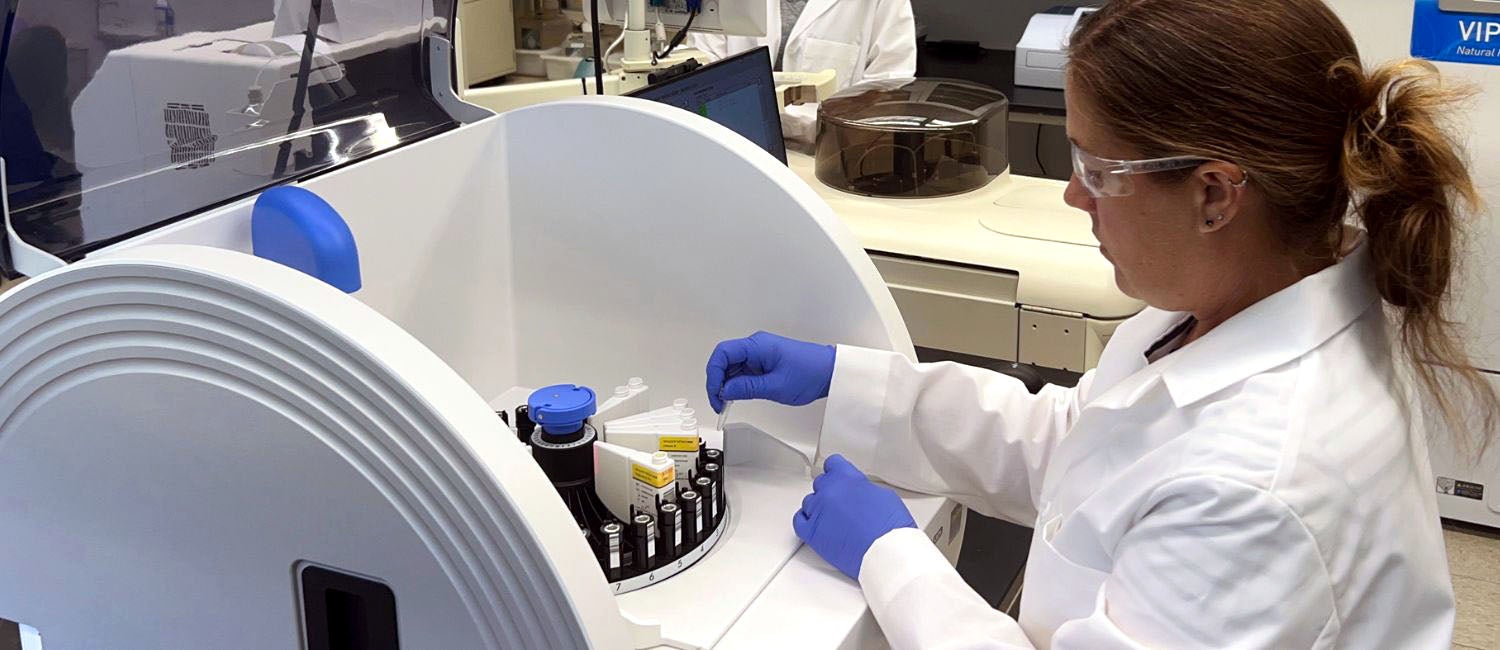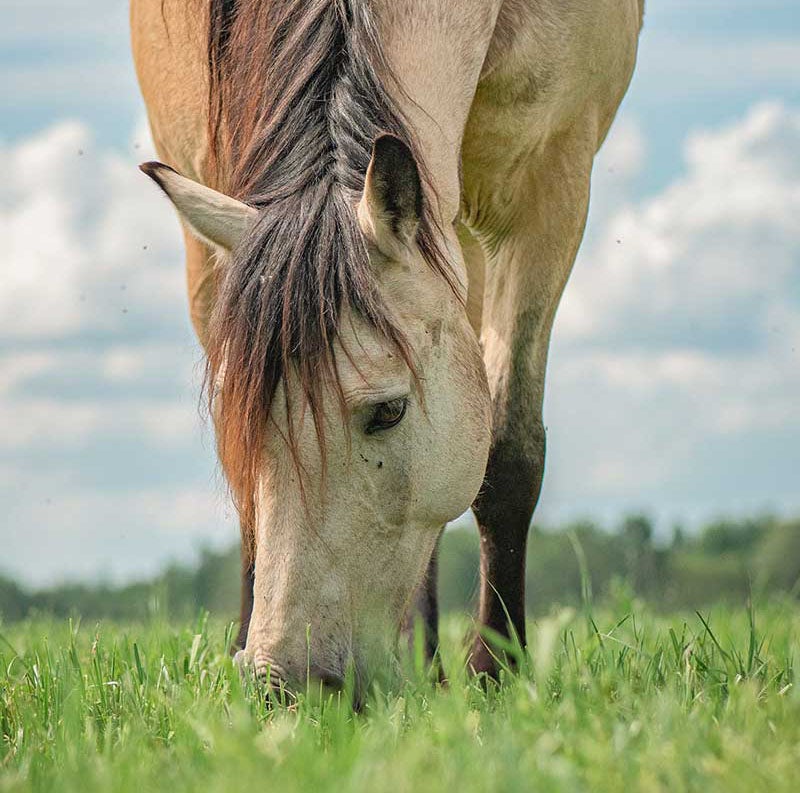
Assay Services
Available Diagnostic Tests
We offer a range of diagnostic endocrine tests for clinical use.
Veterinarians may submit samples through the New Bolton Center Clinical Laboratory using the Equine Endocrinology submission form (PDF).
See the shipping section of our FAQ for information about our new $25 flat-rate courier shipping labels.
Please ship samples to:
University of Pennsylvania
Attn: van Eps Lab Myrin 106
382 W Street Road
Kennett Square, PA 19348
| INDIVIDUAL ASSAYS | SAMPLE TYPE |
|---|---|
| Insulin | Serum |
| Insulin monitoring (x 5 samples) | Serum |
| ACTH | EDTA plasma |
| Progesterone | Serum |
| Adiponectin | Serum |
| Bile acids | Serum |
| Triglycerides | Serum |
| COMBINATIONS / PANELS* | SAMPLE TYPE |
|---|---|
| Insulin and ACTH | Serum and EDTA plasma |
| Insulin and adiponectin | Serum |
| Adiponectin and leptin | Serum |
| Endocrine panel: ACTH, insulin, adiponectin, glucose, triglycerides (can add leptin) | Serum and EDTA plasma |
| Insulin dysregulation panel: insulin, adiponectin, glucose, triglycerides (can add leptin) | Serum |
| Insulin dysregulation panel with GGT and bile acids | Serum |
| Combined OST / TRH Stim | Serum and EDTA plasma |
Follow the guidelines below prior to shipping on ice:
- Serum – Red top vacutainer; allow clot formation (30-60 min at room temp), centrifuge after clot forms, transfer supernatant to a leakproof tube and discard red cells. Label new tube with owner, animal ID and as “SERUM”
- Plasma – Purple top EDTA vacutainer; gently invert to mix, centrifuge ASAP, transfer supernatant to a leakproof tube and discard red cells. Label new tube with owner, animal ID and as “EDTA PLASMA”
- Refrigerate or freeze samples and ship with freezer packs or on wet or dry ice. Do not send whole blood.

Frequently asked questions
The van Eps lab is pleased to offer clinicians the ability to, at their convenience, request and print discounted $25 priority overnight sample shipping labels. Clinicians from anywhere in the continental United States can register to become “Collaborators” in our eShip portal, at which point they will be able to log in to their personal account to create and print priority overnight shipping labels through FedEx or UPS.
To register to become a collaborator, please fill out the following form and a member of the van Eps lab will email you to finish activating your new account.
- No grain for four hours prior, access to hay is fine.
- Take a baseline blood sample for insulin concentration.
- Give 0.15 mL/kg bwt corn syrup (Karo Syrup Light with the red label) orally via dose syringe.
- Take a blood sample at 60 min and at 90 min after the oral sugar dose for insulin concentration.
- Insulin — red top vacutainer
- ACTH — purple top EDTA vacutainer
- Adiponectin — red top vacutainer
- Progesterone — red top vacutainer
- Bile acids — red top vacutainer
Collect blood in a red top vacutainer. Allow clot formation (30-60 min at room temp), centrifuge after clot forms, transfer supernatant to a leakproof tube and discard red cells. Label new tube with owner, animal ID and as “SERUM”
Collect blood in a purple top EDTA vacutainer; gently invert to mix, centrifuge ASAP, transfer supernatant to a leakproof tube and discard red cells. Label new tube with owner, animal ID and as “EDTA PLASMA”
Please ship to:
University of Pennsylvania — New Bolton Center
Attn: van Eps Lab — Myrin 106
382 W Street Road
Kennett Square, PA 19348
It is generally more useful to get a non-fasted blood sample, either randomly across the course of the day, or 1-2 hours post feed/pasture access.
- Feeding has minimal effects on baseline ACTH measurement.
- A TRH stimulation test should not be performed within 4 hours of grain consumption or oral sugar testing.
Stress or pain can increase insulin and ACTH concentrations in the blood and this should be taken into account in horses and ponies with active laminitis in particular. However, the increases are relatively minor and unlikely to affect the diagnosis of insulin dysregulation or PPID in most cases.
Adiponectin is a marker of insulin dysregulation/EMS and laminitis risk. It is a key regulator of glucose and lipid metabolism and has insulin sensitizing, anti-inflammatory and antioxidant effects. Unlike leptin, low adiponectin is strongly associated with insulin dysregulation and laminitis risk (not just obesity). Low adiponectin is an independent risk factor and relatively strong predictor of laminitis.
Adiponectin concentrations are unaffected by stress / feed / grain access prior to sampling and therefore may be a more reliable indicator of metabolic status and laminitis risk than single insulin measurements. If possible, it is ideal to measure both insulin and adiponectin when screening horses and ponies. Adiponectin is most valuable as a tool to identify horses and ponies with ID and a high risk of laminitis — particularly when they have normal resting insulin. Management including diet, weight loss, exercise and medication can improve adiponectin concentration over time, but in our experience increases in adiponectin can take several months. Counter-intuitively, short term decreases in adiponectin commonly occur in the initial weeks to months after institution of appropriate dietary control, weight loss and confinement (in laminitic cases) and this may reflect decreases in fat and/or muscle mass in the short term. Increases in adiponectin may take longer, therefore repeat measurement every 6–12 months as part of a screening program is recommended, however serial monitoring over weeks / months in newly identified ID / laminitis cases may not be beneficial.
Further reading on adiponectin below.
- Menzies-Gow NJ, Knowles EJ, Rogers I, et al. Validity and application of immunoturbidimetric and enzyme-linked immunosorbent assays for the measurement of adiponectin concentration in ponies. Equine Vet J 2019;51:33-37.
- Menzies-Gow NJ, Harris PA, Elliott J. Prospective cohort study evaluating risk factors for the development of pasture-associated laminitis in the United Kingdom. Equine Vet J 2017;49:300-306.
- Knowles EJ, Elliott J, Harris PA, et al. Predictors of laminitis development in a cohort of nonlaminitic ponies. Equine Vet J 2023;55:12-23.
- Elliott J, Bailey SR. Consequences of adiponectin deficiency: Can they be related to the pathophysiology of laminitis? Equine Vet J 2023;55:346-349.
Normal insulin and normal (high) adiponection
Although dynamic testing (OST or post-feed) could be performed, the combination of normal adiponectin and normal insulin on a non-fasted resting sample is a strong indication that the animal is metabolically healthy and has a low risk for laminitis. It may still be worthwhile considering continued annual screening depending on breed, age, body condition and other factors.
High insulin and low adiponectin
- This is strongly supportive of ID/EMS, even without dynamic testing.
- In all cases, feed and management changes should be initiated.
- In cases where the resting insulin is only mildly increased (<50 uIU/mL) further testing with OST or post-prandial insulin testing (2 hours post hay/grain/pasture access, 1 hour post ration balancer) is indicated.
- In severely hyperinsulinemic animals (>100 uIU/ml) it is ideal to first confirm the hyperinsulinemia on at least one more sample prior to considering initiating pharmaceutical therapy to help reduce blood insulin.
Normal insulin and low adiponectin
This result may be best viewed as a warning that the horse is more likely to become hyperinsulinemic at other times (especially in response to feed / pasture high in non-structural carbohydrate). Although adiponectin is very stable (not affected by feed / stress) insulin is very dynamic, so a one-off sample is often not representative.
A low adiponectin may also make a horse or pony more susceptible to laminitis as a result of high insulin (based on evidence from pony studies, low adiponectin is an independent risk factor for laminitis — independent of ID status). Similar to humans with metabolic syndrome, adiponectin may be somewhat protective against the deleterious effects of EMS / ID in horses and ponies.
In these cases further insulin testing is indicated: OST or post-prandial insulin (2 hours post hay / grain / pasture access, 1 hour post ration balancer). This will tell you how worried you need to be about insulin under the current management conditions — and how concerned you need to be if there is pasture access particularly in spring / summer. If this further testing is normal then there is no need to act further, but regular monitoring (at least yearly) is indicated. If OST / post-feed insulin is high then consider feed / management changes etc. to address it.
High insulin and normal (high) adiponectin
A mild increase in insulin (<50 uIU/ml) with normal adiponectin warrants further insulin testing: OST or post-prandial insulin (2 hours post hay / grain / pasture access, 1 hour post ration balancer) to guide further decision making. It is important to note that this result may be due to stress / transport / sedation or feed access prior to sampling causing a transient mild increase in insulin — insulin is dynamic and readily affected by these factors, whereas adiponectin is much more stable.
In severely hyperinsulinemic animals (>100 uIU/ml), regardless of adiponectin result, management / feed change and medication to help control insulin should be considered immediately — it is ideal to first confirm the hyperinsulinemia on at least one more sample prior to initiating therapy. Severe hyperinsulinemia with normal adiponectin is an extremely rare combination.
Management including diet, weight loss, exercise, and medication can improve adiponectin concentration over time, but in our experience increases in adiponectin can take several months. Counter-intuitively, short term decreases in adiponectin commonly occur in the initial weeks to months after institution of appropriate dietary control, weight loss, and confinement (in laminitic cases) and this may reflect decreases in fat and / or muscle mass in the short term. Increases in adiponectin may take longer, therefore repeat measurement every 6–12 months as part of a screening program is recommended, however serial monitoring over weeks / months in newly identified ID / laminitis cases may not be beneficial.
Leptin, an obesity marker, has not been shown to correlate well with insulin dysregulation and laminitis risk; however, results of our latest studies in light breed horses show that the Leptin:Adiponectin ratio (leptin divided by adiponectin) has a stronger association with both pre-existing insulin dysregulation and laminitis in horses compared to adiponectin alone. Although adiponectin is a valuable metabolic marker on its own, the Leptin:Adiponectin ratio “normalizes” it to overall adiposity (measured by leptin) and this appears to improve its accuracy as a marker of overall metabolic health and laminitis risk in light breed horses. A leptin/adiponectin ratio of <1 is ideal and most healthy horses fall into this range; >1 indicates higher likelihood of metabolic dysfunction, insulin dysregulation and laminitis.
Questions?
For research / bulk assay questions please contact Jeaneen Kulp: jckulp@vet.upenn.edu
List of instruments and assay menus:
- Siemens Immulite 2000 XPi
- Tosoh AIA-360
- DiaSys Respons910
- Luminex 200
- Various ELISAs routinely performed, others can be developed and/or validated on request.
